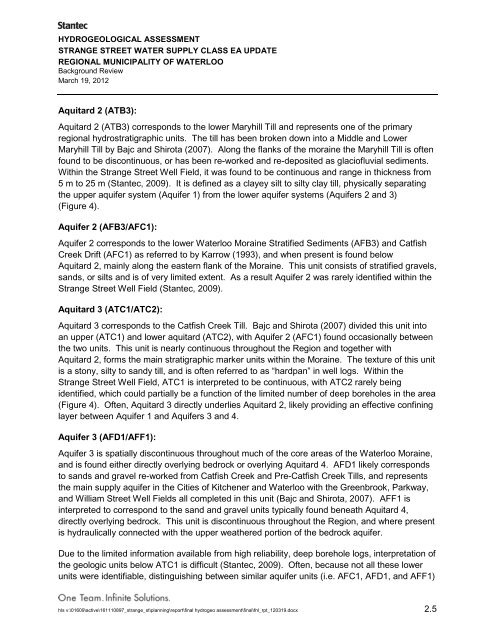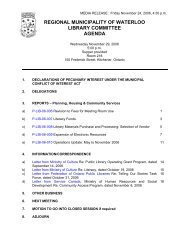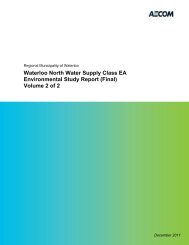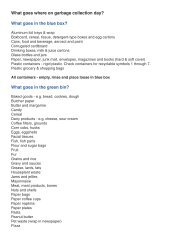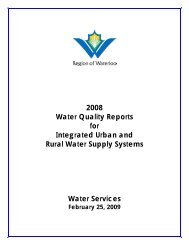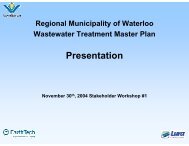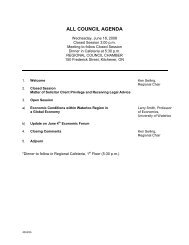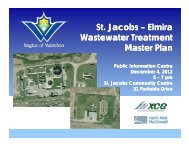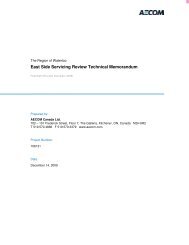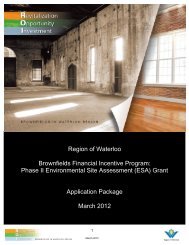HYDROGEOLOGICAL ASSESSMENTSTRANGE STREET WATER SUPPLY CLASS EA UPDATEREGIONAL MUNICIPALITY OF WATERLOOBackground ReviewMarch 19, 2012The following presents details <strong>of</strong> the conceptual model based on Terraqua (1995) and Bajc andShirota (2007). The local hydrostratigraphic model is summarized in Figure 4, which is an eastto west cross section through the Strange Street Well Field:Aquitard 1 (ATB1):Aquitard 1 consists <strong>of</strong> low permeability, spatially discontinuous, surficial till units foundpredominantly along the flanks <strong>of</strong> the <strong>Waterloo</strong> Moraine, which are readily identified in surficialgeology mapping. Along the western flank <strong>of</strong> the moraine, Aquitard 1 corresponds to theMornington, Stratford and Tavistock Tills; whereas along the eastern flank <strong>of</strong> the Moraine, thisunit corresponds to the Upper Maryhill and Port Stanley Tills (Bajc and Shirota, 2007). Withinthe Strange Street Well Field, ATB1 is identified as a silt to clayey till, with a maximum thickness<strong>of</strong> 15 m. It is found at higher elevations, and where the ground surface elevation drops, the unitis not typically present, or is thinner as is evident in Figure 4.Aquifer 1(AFB1/ATB2/AFB2):Aquifer 1 represents the main water supply aquifer in the core areas <strong>of</strong> the <strong>Waterloo</strong> Moraine.The Strange Street Well Field is completed in Aquifer 1 and represents the most eastern wellfield completed in this unit. Depending on the depositional environment, the composition <strong>of</strong>Aquifer 1 can vary from a layered silt and fine sand to coarse sand and gravel. Aquifer 1 isinterpreted to be bisected by the middle Maryhill Till (ATB2), effectively separating Aquifer 1 intotwo units, AFB1 and AFB2. Within the Strange Street Well Field, AFB1 consists <strong>of</strong> a range <strong>of</strong>fine to medium sands, and is not continuous. It is most prominent at higher elevations, andtherefore when the ground surface elevation drops <strong>of</strong>f to the east, AFB1 is observed to thin orpinch out (Stantec, 2009).Within the Strange Street Well Field, ATB2 is found to be a discontinuous, silty to clayey till unit.This unit is typically thicker towards the core area <strong>of</strong> the <strong>Waterloo</strong> Moraine, and it either thins oris not present in the eastern portion <strong>of</strong> the Strange Street Well Field (Figure 4). The presence <strong>of</strong>ATB2 may locally impact the vertical movement <strong>of</strong> groundwater through Aquifer 1 whereverpresent, however, on a large scale, Aquifer 1 is interpreted to behave as a single system.All <strong>of</strong> the current Production Wells (K10A, K11, K13, K18, and K19) within the Strange StreetWell Field are interpreted to be screened within AFB2. This layer typically ranges in thicknessfrom 0 to 40 m, with an average thickness <strong>of</strong> about 10 m and is typically not present below anelevation <strong>of</strong> 310 m AMSL. It is predominantly defined by fine and medium sand, silt, and gravelbased on continuous core logging data. As was the case for AFB1, AFB2 appears to pinch outlocally to the east (Figure 4) and to the south (Stantec, 2009). This interpretation is furtheraugmented by the fact that former Production Wells in the east (K15, K16 and K17), as well aswells in the nearby Greenbrook Well Field, were all completed in lower aquifer systems,presumably because Aquifer 1 was not sufficiently thick to support a municipal well.2.4 hls v:\01609\active\161110897_strange_st\planning\report\final hydrogeo assessment\final\fnl_rpt_120319.docx
HYDROGEOLOGICAL ASSESSMENTSTRANGE STREET WATER SUPPLY CLASS EA UPDATEREGIONAL MUNICIPALITY OF WATERLOOBackground ReviewMarch 19, 2012Aquitard 2 (ATB3):Aquitard 2 (ATB3) corresponds to the lower Maryhill Till and represents one <strong>of</strong> the primaryregional hydrostratigraphic units. The till has been broken down into a Middle and LowerMaryhill Till by Bajc and Shirota (2007). Along the flanks <strong>of</strong> the moraine the Maryhill Till is <strong>of</strong>tenfound to be discontinuous, or has been re-worked and re-deposited as glaci<strong>of</strong>luvial sediments.Within the Strange Street Well Field, it was found to be continuous and range in thickness from5 m to 25 m (Stantec, 2009). It is defined as a clayey silt to silty clay till, physically separatingthe upper aquifer system (Aquifer 1) from the lower aquifer systems (Aquifers 2 and 3)(Figure 4).Aquifer 2 (AFB3/AFC1):Aquifer 2 corresponds to the lower <strong>Waterloo</strong> Moraine Stratified Sediments (AFB3) and CatfishCreek Drift (AFC1) as referred to by Karrow (1993), and when present is found belowAquitard 2, mainly along the eastern flank <strong>of</strong> the Moraine. This unit consists <strong>of</strong> stratified gravels,sands, or silts and is <strong>of</strong> very limited extent. As a result Aquifer 2 was rarely identified within theStrange Street Well Field (Stantec, 2009).Aquitard 3 (ATC1/ATC2):Aquitard 3 corresponds to the Catfish Creek Till. Bajc and Shirota (2007) divided this unit intoan upper (ATC1) and lower aquitard (ATC2), with Aquifer 2 (AFC1) found occasionally betweenthe two units. This unit is nearly continuous throughout the <strong>Region</strong> and together withAquitard 2, forms the main stratigraphic marker units within the Moraine. The texture <strong>of</strong> this unitis a stony, silty to sandy till, and is <strong>of</strong>ten referred to as “hardpan” in well logs. Within theStrange Street Well Field, ATC1 is interpreted to be continuous, with ATC2 rarely beingidentified, which could partially be a function <strong>of</strong> the limited number <strong>of</strong> deep boreholes in the area(Figure 4). Often, Aquitard 3 directly underlies Aquitard 2, likely providing an effective confininglayer between Aquifer 1 and Aquifers 3 and 4.Aquifer 3 (AFD1/AFF1):Aquifer 3 is spatially discontinuous throughout much <strong>of</strong> the core areas <strong>of</strong> the <strong>Waterloo</strong> Moraine,and is found either directly overlying bedrock or overlying Aquitard 4. AFD1 likely correspondsto sands and gravel re-worked from Catfish Creek and Pre-Catfish Creek Tills, and representsthe main supply aquifer in the Cities <strong>of</strong> Kitchener and <strong>Waterloo</strong> with the Greenbrook, Parkway,and William Street Well Fields all completed in this unit (Bajc and Shirota, 2007). AFF1 isinterpreted to correspond to the sand and gravel units typically found beneath Aquitard 4,directly overlying bedrock. This unit is discontinuous throughout the <strong>Region</strong>, and where presentis hydraulically connected with the upper weathered portion <strong>of</strong> the bedrock aquifer.Due to the limited information available from high reliability, deep borehole logs, interpretation <strong>of</strong>the geologic units below ATC1 is difficult (Stantec, 2009). Often, because not all these lowerunits were identifiable, distinguishing between similar aquifer units (i.e. AFC1, AFD1, and AFF1)hls v:\01609\active\161110897_strange_st\planning\report\final hydrogeo assessment\final\fnl_rpt_120319.docx 2.5
- Page 2 and 3: August 26, 2011Sam ZiemannPage 2 of
- Page 4 and 5: August 26, 2011Sam ZiemannPage 4 of
- Page 6 and 7: August 26, 2011Sam ZiemannPage 6 of
- Page 8 and 9: August 26, 2011Sam ZiemannPage 8 of
- Page 10 and 11: August 26, 2011Sam ZiemannPage 10 o
- Page 12 and 13: August 26, 2011Sam ZiemannPage 12 o
- Page 14 and 15: Pressure (kPa)K18/K19 Well House to
- Page 16 and 17: Figure 4a - Existing ConditionsPump
- Page 18 and 19: Figure 6a - Existing System w/Combi
- Page 20 and 21: Figure 8a - Existing ConditionsWell
- Page 22 and 23: Figure 10a - Future System w/Combin
- Page 24 and 25: MD-80 CATALYTIC MEDIAIRON, MANGANES
- Page 26 and 27: NR - Pressure FiltersHorizontal and
- Page 28 and 29: Napier-Reid Ltd.Pressure FiltersSal
- Page 30 and 31: APPENDIX EHydrogeological Assessmen
- Page 32 and 33: HYDROGEOLOGICAL ASSESSMENTSTRANGE S
- Page 34 and 35: HYDROGEOLOGICAL ASSESSMENTSTRANGE S
- Page 36 and 37: HYDROGEOLOGICAL ASSESSMENTSTRANGE S
- Page 38 and 39: HYDROGEOLOGICAL ASSESSMENTSTRANGE S
- Page 42 and 43: HYDROGEOLOGICAL ASSESSMENTSTRANGE S
- Page 44 and 45: HYDROGEOLOGICAL ASSESSMENTSTRANGE S
- Page 46 and 47: HYDROGEOLOGICAL ASSESSMENTSTRANGE S
- Page 48 and 49: HYDROGEOLOGICAL ASSESSMENTSTRANGE S
- Page 50 and 51: HYDROGEOLOGICAL ASSESSMENTSTRANGE S
- Page 52 and 53: HYDROGEOLOGICAL ASSESSMENTSTRANGE S
- Page 54 and 55: HYDROGEOLOGICAL ASSESSMENTSTRANGE S
- Page 56 and 57: HYDROGEOLOGICAL ASSESSMENTSTRANGE S
- Page 58 and 59: HYDROGEOLOGICAL ASSESSMENTSTRANGE S
- Page 60 and 61: HYDROGEOLOGICAL ASSESSMENTSTRANGE S
- Page 62 and 63: HYDROGEOLOGICAL ASSESSMENTSTRANGE S
- Page 64 and 65: HYDROGEOLOGICAL ASSESSMENTSTRANGE S
- Page 66 and 67: HYDROGEOLOGICAL ASSESSMENTSTRANGE S
- Page 68 and 69: HYDROGEOLOGICAL ASSESSMENTSTRANGE S
- Page 70: HYDROGEOLOGICAL ASSESSMENTSTRANGE S
- Page 78 and 79: 25Pumping Rate20Pumping Rate (L/s)1
- Page 80 and 81: HYDROGEOLOGICAL ASSESSMENTSTRANGE S
- Page 82 and 83: TABLE 2SUMMARY OF GROUNDWATER ANALY
- Page 84 and 85: CALCULATION OF SPECIFIC CAPACITY FR
- Page 111 and 112:
March 2, 2011Reference: 006-189Stan
- Page 113 and 114:
TABLE 1REGIONAL MUNICIPALITY OF WAT
- Page 132 and 133:
HYDROGEOLOGICAL ASSESSMENTSTRANGE S
- Page 134 and 135:
July 23, 2010Lisa Lachuta, P.Eng.Pa
- Page 136 and 137:
July 23, 2010Lisa Lachuta, P.Eng.Pa
- Page 138 and 139:
July 23, 2010Lisa Lachuta, P.Eng.Pa
- Page 140:
TECHNICAL MEMORANDUM A1 -STRANGE ST
- Page 143 and 144:
TECHNICAL MEMORANDUM A1 -STRANGE ST
- Page 145:
TABLE 1SUMMARY OF GROUNDWATER ANALY


